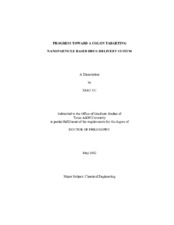| dc.description.abstract | Hydrophobic drug paclitaxel nanoparticles (PAX NPs) and pH sensitive hydrogels were prepared in this study to build a colon targeting nanoparticle based drug delivery system for oral administration.
Negative charged PAX NPs at the size of 110 +/- 10 nm were fabricated, characterized and then encapsulated in synthetic / biomacromolecule shell chitosan, dextran-sulfate using a layer by layer (LbL) self-assembly technique. Surface modifications were performed by covalently conjugating with poly (ethylene glycol) (H2N-PEG-carboxymethyl, Mw 3400) and fluorescence labeled wheat germ agglutinin (F-WGA), so as to build a biocompatible and targeted drug delivery system. Extended release of drug paclitaxel can be realized by adding more polyelectrolyte layers in the shell. High cell viability with PEG conjugated and high binding capacities of WGA modified nanoparticles with Caco-2 cells were observed. Preliminary study on stability of the nanoparticles in suspension at different pH was also performed.
Two dextran based pH sensitive and enzyme degradable hydrogels: dextran maleic acid (Dex-MA), and glycidyl methacrylated dextran (Dex-GMA) were synthesized for oral delivery of nanoparticles. Hydrogels of both kinds were stable in simulated gastric fluid, but were prone to swelling and degradation in the presence or absence of enzyme dextranase in simulated intestinal fluid. The release profiles of nanoparticles could be tuned from 5 hr to 24 hr periods of time with more than 85% of the nanoparticle released in the simulated intestinal fluid. The release of PAX NPs was completed with longer time periods (45 hr-120 hr). Two possible release mechanisms were discussed for Dex-MA and Dex-GMA-co-AA hydrogels respectively: degradation controlled, and diffusion controlled.
These biodegradable hydrogels, which can release nanoparticles depending on pH changes, together with the biocompatible and targeted nanoparticles, may be suitable as a potential colon targeting system for oral delivery of drug nanoparticles. | en |


